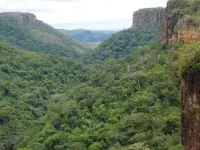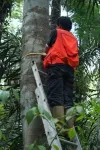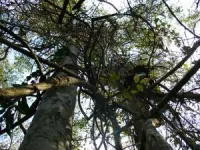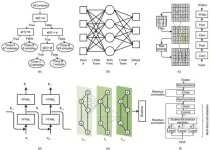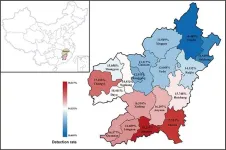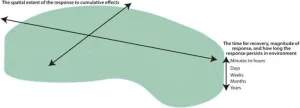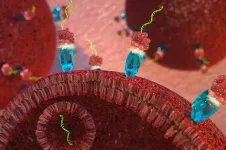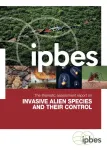(Press-News.org) Extreme El Niño weather saw South America’s forest carbon sink switch off
Hot and dry conditions resulted in increased tree death
Evidence that most forest areas withstand periods of severe drought
Greatest impact in forests with drier climates
Tropical forests in South America lose their ability to absorb carbon from the atmosphere when conditions become exceptionally hot and dry, according to new research.
For a long time, tropical forests have acted as a carbon sink, taking more carbon out of the air than they release into it, a process that has moderated the impact of climate change.
But research led by Dr Amy Bennett, a Research Fellow at the University of Leeds, found that in 2015 – 2016, when an El Niño climate event resulted in drought and the hottest temperatures ever recorded, South American forests were unable to function as a carbon sink.
El Niño occurs when sea-surface temperatures in the Pacific Ocean increase sharply, triggering a major shift in the world’s climate system. In 2015-2016, the result was exceptionally hot weather for South America. A similar event is underway now.
Dr Bennett, from the School of Geography at Leeds, said: “Tropical forests in the Amazon have played a key role in slowing the build-up of carbon dioxide in the atmosphere.
“Scientists have known that the trees in the Amazon are sensitive to changes in temperature and water availability, but we do not know how individual forests could be changed by future climate change.
“Investigating what happened in the Amazon during this huge El Niño event gave us a window into the future by showing how unprecedented hot and dry weather impacts forests.”
The researchers today report their findings in the journal Nature Climate Change. The study united the RAINFOR and PPBio research networks, with dozens of short-term grants enabling more than 100 scientists to measure forests for decades across 123 experimental plots.
The plots span Amazon and Atlantic forests as well as drier forests in tropical South America.
These direct, tree-by-tree records showed that most forests had acted as a carbon sink for most of the last 30 years, with tree growth exceeding mortality. When the 2015–2016 El Niño hit, the sink shut down. This was because tree death increased with the heat and drought.
Professor Beatriz Marimon, of Brazil’s Mato Grosso State University, added “Here in the southeastern Amazon on the edge of the rainforest, the trees may have now switched from storing carbon to emitting it. While tree growth rates resisted the higher temperatures, tree mortality jumped when this climate extreme hit.”
Study’s findings
Of the 123 plots studied, 119 of them experienced an average monthly temperature increase of 0.5 degrees Celsius. 99 of the plots also suffered water deficits. Where it was hotter, it was also drier.
Prior to El Niño, the researchers calculated that the plots were storing and sequestering around one third of a tonne of carbon per hectare per year. This declined to zero with the hotter and drier El Niño conditions.
The change was due to biomass being lost through the death of trees.
Writing in the paper, the researchers noted that the greatest relative impact of the El Niño event were in forests where the long-term climate was already relatively dry.
The expectation was that wetter forests would be most vulnerable to the extreme drier weather, as they would be least adapted to such conditions. However, the opposite was the case. Instead, those forests more used to a drier climate at the dry periphery of the tropical forest biome turned out to be most vulnerable to drought.
This suggested some trees were already operating at the limits of tolerable conditions.
For Professor Oliver Phillips, an ecologist at the University of Leeds who supervised the research and leads the global ForestPlots initiative, the findings offered hope about the resilience of the South American tropical nature.
He added: “The full 30-year perspective that our diverse team provides shows that this El Niño had no worse effect on intact forests than earlier droughts. Yet this was the hottest drought ever.
“Where tree mortality increased was in the drier areas on the Amazon periphery where forests were already fragmented. Knowing these risks, conservationists and resource managers can take steps to protect them.
“Through the complex dynamics that happen in forest environments, land clearance makes the environment drier and hotter, further stressing the remaining trees.
“So, the big challenge is to keep forests standing in the first place. If we can do that, then our on-the-ground evidence shows they can continue to help lock up carbon and slow climate change.”
Two reports are published in Nature Climate Change related to this research. The scientific paper, “Sensitivity of South American tropical forests to an extreme climate anomaly”, and a research brief titled “Impact of the 2015-2016 El Nino on South American tropical forests”.
Once the paper is live, it can be downloaded from the journal website: https://www.nature.com/articles/s41558-023-01776-4
END
Extreme El Niño weather saw South America’s forest carbon sink switch off
2023-09-04
ELSE PRESS RELEASES FROM THIS DATE:
Blowing snow contributes to Arctic warming
2023-09-04
When it comes to global warming trends, the Arctic is a troubling outlier. The Arctic warms nearly four times faster than the global average, and aerosols play an important role in that warming. Scientists have long known that pollutants from other regions can accumulate in the Arctic atmosphere where they alter atmospheric chemistry, absorb sunlight, and affect local weather patterns, leading to localized warming that melts ice and snow. Sea salt particles dominate aerosol mass concentration, but their production mechanisms and impact on Arctic climate have remained unclear.
Atmospheric scientists led by Jian Wang, director of the Center for Aerosol ...
Innovative solutions for chemical challenges: Harnessing the potential of machine learning
2023-09-04
In a review published in Engineering, scientists explore the burgeoning field of machine learning (ML) and its applications in chemistry. Titled “Machine Learning for Chemistry: Basics and Applications,” this comprehensive review aims to bridge the gap between chemists and modern ML algorithms, providing insights into the potential of ML in revolutionizing chemical research.
Over the past decade, ML and artificial intelligence (AI) have made remarkable strides, bringing us closer to the realization of intelligent machines. The advent of deep learning methods and enhanced data storage capabilities has played a pivotal role in this progress. ML has already demonstrated success ...
Uncovering thalassemia diversity in southern china through next-generation sequencing
2023-09-04
Around 5.2% of the global population carries abnormal hemoglobin genes [1]. Each year, 300,000 to 500,000 children are born with severe hemoglobinopathies worldwide, with approximately 80% of these cases occurring in developing countries [2]. Thalassemia is the most common hereditary hemoglobinopathy and occurs in 4.4 out of every 10,000 live births [3]. It is prevalent in Mediterranean coastal areas, Africa, the Middle East, Southeast Asia, and southern China.
A previous study indicated that Ganzhou, the southernmost city in Jiangxi province, had a thalassemia prevalence ...
NYU Abu Dhabi researchers develop novel tumor-targeting nanospheres with the potential to dramatically improve light-based cancer diagnosis and treatment
2023-09-04
Abu Dhabi, UAE (September 4, 2023) – In a breakthrough in cancer therapeutics, a team of researchers at the Magzoub Biophysics Lab at NYU Abu Dhabi (NYUAD) has made a significant advance in light-based therapies – biocompatible and biodegradable tumor-targeting nanospheres that combine tumor detection and monitoring with potent, light-triggered cancer therapy to dramatically increase the efficacy of existing light-based approaches.
Non-invasive, light-based therapies, photodynamic therapy (PDT) and photothermal therapy (PTT) have the potential to be safe and effective alternatives to conventional cancer treatments, which are beset by a ...
Ecosystem footprint concept and its potential applications in environmental management
2023-09-04
Traditionally, the impact of human activity on an ecosystem has lacked context when planning restorative ecosystem mitigation and management strategies. Multiple human activities over time and space, the resilience of a particular ecosystem, and the stress caused by many individual or related, overlapping activities that generate cumulative effects may affect the overall "ecosystem response footprint," or ability of an ecosystem to adapt and change to human activity.
A team of marine scientists reviewed the most recent perspectives on ecological footprints to rigorously define the term "ecosystem response footprint" as the ...
First-in-class targeted microRNA therapy slows cancer tumor growth
2023-09-04
WEST LAFAYETTE, Ind. – A new cancer therapy developed by Purdue University researchers attacks tumors by tricking cancer cells into absorbing a snippet of RNA that naturally blocks cell division. As reported today in Oncogene, tumors treated with the new therapy did not increase in size over the course of a 21-day study, while untreated tumors tripled in size over the same time period.
Cancer can begin almost anywhere in the human body. It is characterized by cells that divide uncontrollably and that may be able to ignore signals to ...
Invasive Alien Species Pose Major Global Threats to Nature, Economies, Food Security and Human Health: IPBES report
2023-09-04
The severe global threat posed by invasive alien species is underappreciated, underestimated, and often unacknowledged. According to a major new report by the Intergovernmental Platform on Biodiversity and Ecosystem Services (IPBES), more than 37,000 alien species have been introduced by many human activities to regions and biomes around the world. This conservative estimate is now rising at unprecedented rates. More than 3,500 of these are harmful invasive alien species – seriously threatening nature, nature’s contributions to people and good quality of life. Too often ignored until it is too late, invasive alien species are a ...
Korean Scientific payload for observing the lunar space environment begins its transfer to the US for the scheduled 2024 launch
2023-09-04
The Ministry of Science and ICT (Minister Jong-Ho Lee, hereinafter referred to as 'MSIT') and the Korea Astronomy and Space Science Institute (Director Young-Deuk Park, hereinafter referred to as 'KASI') announced the beginning of the transfer of the lunar space environment monitor, 'LUSEM'(Lunar Space Environment Monitor) that will be aboard United States’ unmanned lunar lander in 2024, has began on September 4th.
LUSEM is a payload developed by the Korea Astronomy and Space Science Institute (KASI) in participation with the U.S. NASA's CLPS(Commercial Lunar Payload Services) initiative ...
IOP Publishing appoints Dr. David Gevaux as Chief Editor of Reports on Progress in Physics
2023-09-04
IOP Publishing (IOPP) has appointed Dr. David Gevaux as the first Chief Editor of Reports on Progress in Physics. Taking up the post from the 4th of September, Dr. Gevaux will lead on ambitious plans for the journal, as its scope expands to include groundbreaking new research content alongside the authoritative reviews for which it is well known across all areas of physics.
Working closely with Professor Subir Sachdev, the Editor in Chief of Reports on Progress in Physics, Dr. Gevaux will champion the editorial ...
New study uncovers the Causes of the Qing Dynasty's Collapse
2023-09-04
The Qing Dynasty in China, after over 250 years, crumbled in 1912. Led by the Complexity Science Hub (CSH), an international research team has pinpointed key reasons behind the collapse, revealing parallels to modern instability and offering vital lessons for the future.
China is considered today to be the world's largest economy (in terms of PPP). However, this position is not new. In 1820, China's economy already held the top spot, accounting for 32.9% of the global GDP. In the interim, there was a period of decline followed by a resurgence. In 1912, after over 250 years in power, the Qing Dynasty collapsed despite being considerably wealthier at the time ...
